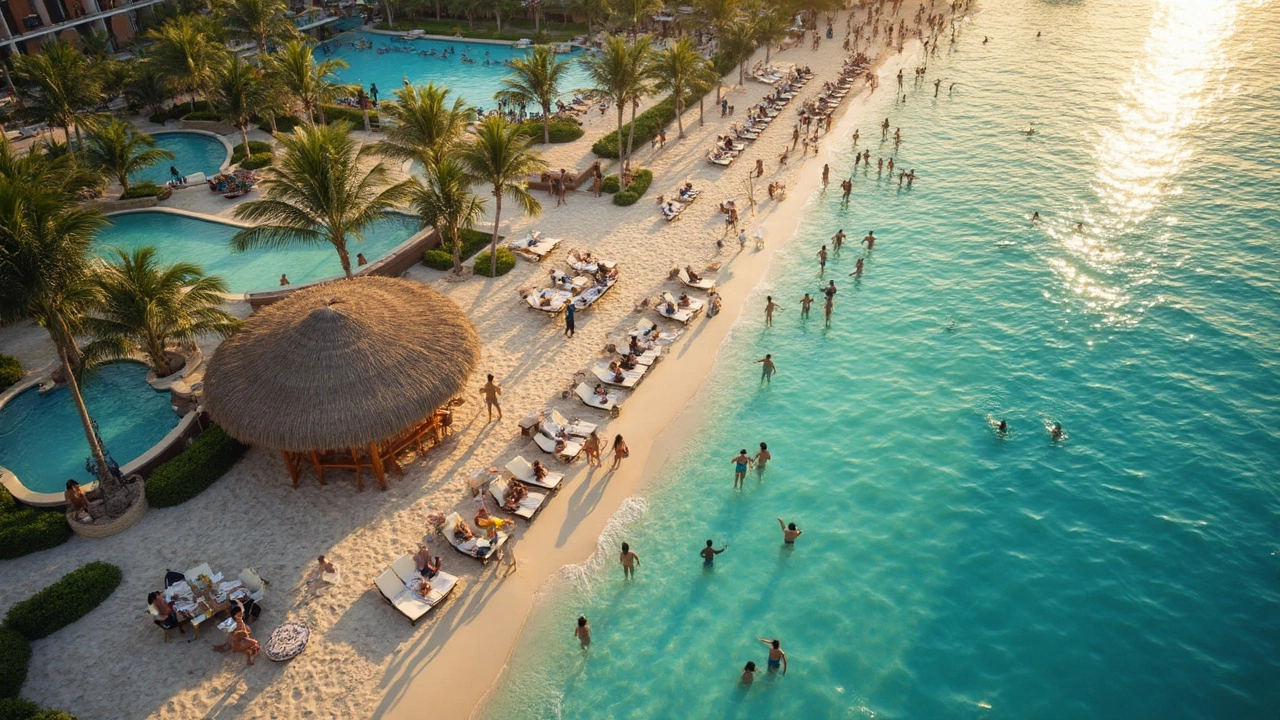Picture this: you show up at your hotel, drop your bags, and just start living your best life—no wallet needed for every meal or round of drinks. That’s the vibe most people expect when they hear “all-inclusive,” but do you always get everything included? Not exactly. Every resort has its own take on what’s in and what’s out, and trust me, the fine print matters way more than you might think.
All-inclusive hotels usually wrap your food, drinks, and lots of activities into the price of the stay. But here’s where it gets sticky—some places count premium drinks, a la carte restaurants, or spa treatments as extras that’ll show up on your bill at checkout. No one loves that surprise. So before you book, take a look at what’s actually included. Some places even have things like snorkeling trips or cooking classes for no extra charge, while others stick to the basics like buffet meals and pool access.
- The True Meaning of All-Inclusive
- What’s Usually Included (and What’s Not)
- Surprising Perks and Hidden Costs
- Tips for Getting the Most Out of Your Stay
The True Meaning of All-Inclusive
If you’re like most people, the idea of an all-inclusive hotel sounds simple: pay once, put your feet up, and forget about extra bills. But the real meaning isn’t always that clear-cut. To really get how it works, it's important to know what’s actually included and how those deals stack up compared to other types of stays.
All-inclusive hotels started out in the Caribbean back in the 1950s, with Club Med leading the way. Their goal? Make vacation planning less stressful by bundling food, drinks, room, and activities into one price. Fast forward to today and you’ll find all-inclusives everywhere—from Mexico and Greece to Thailand—offering similar concepts but with lots of variation in the details.
The core idea behind all-inclusive is covering these basics for each guest, every day:
- Lodging (your room or suite)
- All meals (buffets, some à la carte restaurants, snacks in between)
- Drinks (often both alcoholic and non-alcoholic, but brands and quality can differ)
- Access to pools, gym, beach chairs, and some non-motorized water sports
- Basic entertainment or activities (evening shows, fitness classes, kids’ clubs)
The truth is, each hotel sets up its own rules. Some throw in extras like airport transfers or premium cocktails. Others keep it basic and try to upsell you on everything from lobster dinners to spa time. For families, those kid perks can add big value—it’s not just about unlimited food but also things like supervised play, waterslides, or even free ice cream stands.
When you compare hotel price tags, it pays to know what competitors are offering. Here’s a quick look at what’s usually wrapped into the nightly rate at different types of places:
| Type of Stay | Meals Included | Drinks Included | Activities | Hidden Fees? |
|---|---|---|---|---|
| Standard Hotel | Breakfast (sometimes) | No | Extra cost | Often yes |
| Half-Board | Breakfast & Dinner | No | Extra cost | Sometimes |
| All-Inclusive | All meals & snacks | Most drinks | Lots included | Depends |
A hotel might call itself all-inclusive, but always double-check—some cut costs by limiting options or charging for small things like room service or branded liquors. The best tip? Check reviews and read the hotel’s official list of inclusions before you book, so your "all-inclusive" trip really covers what you want.
What’s Usually Included (and What’s Not)
When you’re booking an all-inclusive hotel, it’s easy to assume everything’s covered. But what you actually get can change a lot depending on where you stay. Most places offer the basics like buffet-style meals, coffee, soda, and standard drinks at hotel bars. You’ll usually have access to the main pool, the beach if it’s near one, and simple activities like fitness classes or volleyball. Some bigger resorts throw in things like nightly entertainment, kids’ clubs, and group activities too.
Here’s a real example of what’s often included at all-inclusive hotels:
- Buffet breakfast, lunch, and dinner
- Selection of house beer, wine, and cocktails
- Coffee, tea, and soft drinks 24/7
- Pool and beach access (sometimes with included chairs and towels)
- Non-motorized water sports like kayaking or paddleboarding
- Group fitness classes and casual games
- Daily and nightly entertainment (think karaoke, live music, dance shows)
But there’s a catch. Not everything on-site is free. Here’s a quick table showing what’s typically not included:
| Common Extras | Notes |
|---|---|
| Premium liquor or bottled wine | Usually costs extra, sometimes only included for VIP guests |
| Specialty or à la carte restaurants | May require a reservation or extra fees |
| Spa treatments and massages | Almost always charged separately |
| Room service after certain hours | 24-hour room service is often not free |
| Motorized water sports (jet skis, boats) | These come with extra safety and fuel costs |
| Airport transfers | Double-check before arriving, they're not always covered |
| Tours and excursions | Outside trips cost extra, even if organized by the hotel |
Different countries may have their own twist, too. For example, in Mexico or the Dominican Republic, most all-inclusives throw in more activities and watersports, while places like Greece or Spain might focus mainly on meals and drinks. If you’re traveling with kids, check for things like included childcare. For adults-only escapes, look for whether the property includes things like nightclubs, romantic dinners, or even golf.
So, don’t rely just on the "all-inclusive" tag. Always read what’s listed in the deal. And if you’re not sure, reach out to the hotel before you book. That way you’ll know what’s really part of the package and what’s going to show up on your final tab.

Surprising Perks and Hidden Costs
So you’re walking into an all-inclusive hotel thinking you’ve got it all covered. Free food, drinks on tap, and activities all day—what could go wrong? Well, sometimes there’s way more than meets the eye, both good and not-so-good.
Let’s start with the perks you might not expect. Some resorts now offer cool extras: free fitness classes, non-motorized water sports, airport transfers, kids’ clubs, and even room service at no extra charge. In Cancun, for example, the Grand Fiesta Americana Coral Beach gives you unlimited spa hydrotherapy sessions—pretty sweet, honestly. In the Caribbean, Club Med properties usually toss in stuff like windsurfing lessons or circus school for kids. These little surprises can stretch your vacation way further than you planned.
But watch out, because hidden costs can sneak up on you fast. The most common surprise? Not every food option is covered. That fancy steakhouse or sushi bar on site might need a reservation and charge a fee, or limit you to just one visit. Alcohol isn’t always unlimited either; most places include well drinks and basic cocktails, but top-shelf options cost extra. Want that bottle of wine with dinner? Get ready to sign for it.
- Spa treatments and salon services almost never come included. Even a simple massage might cost more than you’d pay back home.
- Water sports using motors (like jet skis or parasailing) are rarely free. Snorkeling and kayaks, sure, but speedboats—forget about it.
- Kid-friendly perks like babysitting are often extra, even if the kids’ club itself is free.
Resort fees are another little trick. In places like Mexico and the Dominican Republic, all-inclusive hotels sometimes tack on an extra daily fee for things like Wi-Fi, gym use, or resort maintenance. These can add $20-$40 per night, and they aren’t always clear when you book.
| Included Perk | Common Hidden Cost |
|---|---|
| Buffet and casual restaurants | Steakhouse, sushi, or specialty restaurants |
| Basic cocktails and house wine | Imported/top-shelf liquor |
| Kayaking, paddle boarding | Jet skis, scuba diving lessons |
| Kids’ club activities | Babysitting, private lessons |
| Evening shows and entertainment | Special events or premium seating |
The bottom line? Even when you see the words all-inclusive, a peek at the details matters. Always look for a clear list of what you’re really paying for, and ask about fees ahead of time. That way, you’ll enjoy more of the good surprises and avoid any check-out-day regrets.
Tips for Getting the Most Out of Your Stay
All-inclusive trips can feel like a sweet deal, but you can stretch your money and experience way further with a few smart moves. Most people think you just show up, eat, swim, and repeat—but there's a lot more going on if you know where to look. Here’s how to really make your stay worth it.
- All-inclusive packages almost always include more activities than they actively advertise. Check the events calendar as soon as you check in. Some resorts offer daily yoga, snorkeling, cooking demos, and kids’ clubs. Ask the front desk for a printed list so you don’t miss out.
- Don’t just stick to the main buffet. Many all-inclusives hide à la carte restaurants that require reservations, so book those your first day—spots fill up fast, especially during high season. Some places limit how many times you can eat at these spots during your stay, so prioritize the unique experiences (like a teppanyaki show) first.
- Bartenders usually have both house and top-shelf options. Not all drinks are created equal. Politely ask what brands are included—sometimes if you don’t specify, you’ll get the lower-end choices. Don’t be shy to ask for the good stuff if it’s covered by your plan.
- Spa credits and water sports are often included or discounted, but not always obvious from the start. Look for fine print or ask about these deals at check-in. Things like paddle boards, kayaks, or even tennis court gear are frequently up for grabs at no cost.
- If you want a cabana, book early. At big resorts, prime pool loungers and cabanas go fast. Some are free if you reserve in advance, but you’ll pay a fee if you wait until the day-of.
Here’s a quick look at some typical perks and their availability at popular all-inclusive brands:
| Brand | Specialty Dining | Premium Drinks | Daily Activities | Water Sports |
|---|---|---|---|---|
| Sandals Resorts | Unlimited | Yes | Yes | Scuba, Kayak Free |
| RIU Hotels | Limited (reservations needed) | Selected brands | Yes | Snorkel, Windsurf Included |
| Club Med | Unlimited | Basic, some upgrades cost extra | Extensive | Most Included |
| Secrets Resorts | Unlimited (no reservations needed) | Top-shelf | Yes | Varies by resort |
One last thing—tip the staff if you’re able, even if the resort says gratuities are included. A little something can turn "standard" service into "above and beyond" experiences. You’ll often get local advice, speedier service, or your favorite drink remembered. Remember, reading a few recent guest reviews before you go can save you plenty of rookie mistakes.
